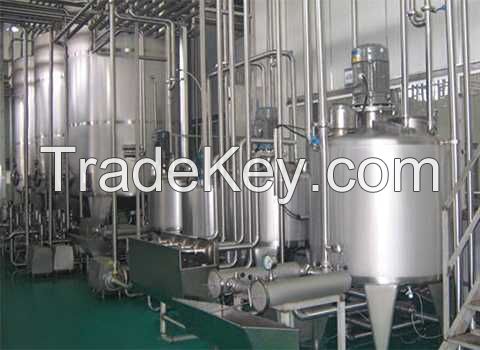

Precio FOB
Obtener el precio más reciente( Negotiable )
|1 Unit Minimum Order
País:
China
N º de Modelo:
-
Precio FOB:
( Negotiable ) Obtener el precio más reciente
Lugar de origen:
China
Precio de pedido mínimo:
-
Cantidad de pedido mínimo:
1 Unit
Detalle de embalaje:
-
El tiempo de entrega:
shipping
Capacidad de suministro:
-
Tipo de pago:
-
Grupo de productos :
Persona de contacto Ms. Shiny
No.5899 Tingwei road,Jinshan Industrial zone, Shanghai, China
The
processing line produce several types of market milk products, i.e.
whole milk, skimmilk and standardised milk of various fat
contents.
Description
The processing line produce several types of
market milk products, i.e. whole milk, skimmilk and standardised
milk of various fat contents.
First the milk is preheated and standardised
by in line milk fat standardisation system. The purpose of
standardisation is to give the milk a defined, guaranteed fat
content. Common values are 1.5% for low fat milk and 3% for regular
grade milk, fat contents as low as 0.1 and 0.5 % is
skimmilk.
Then the standardised milk is homogenised.
The purpose of homogenisation is to disintegrate or finely
distribute the fat globules in the milk in order to reduce
creaming. Homogenisation may be total or partial. Partial
homogenisation is a more economical solution, because a smaller
homogeniser can be used.
The milk, now is pumped to the heating
section of the milk heat exchanger where it is pasteurised. The
necessary holding time is provided by a separate holding tube. The
pasteurisation temperature is recorded continuously. Pump is a
booster pump which increases the pressure of the product to a level
at which the pasteurised product cannot be contaminated by
untreated milk or by the cooling medium if a leak occur in the
plate heat exchanger. If the pasteurisation temperature should
drop, this is sensed by a temperature transmitter. A signal
activates flow diversion valve and the milk flows back to the
balance tank. After pasteurisation the milk continues to a cooling
section in the heat exchanger, where it is regeneratively cooled by
the incoming untreated cold milk, and then to the cooling section
where it is cooled with ice water. The cold milk is then pumped to
the filling machines.
Temperature and pasteurisation holding time
are very important factors which must be specified precisely in
relation to the quality of the milk and its shelf life
requirements. The pasteurisation temperature is usually *2 *5C for
*5 *0 sec. A common requirement is that the heat treatment must
guarantee the destruction of unwanted microorganisms and of all
pathogenic bacteria without the product being
damaged.
Advantages
* Opportunity to realize products with
customized recipes.
* Opportunity to produce more than one
product with the same processing line.
* Very short holding times at pasteurizing
temperature.
* Accurate dosing of mixing and additional
aromas.
* High quality of the final product keeping
an elevated nutritional value.
* Wide customization of the final
product.
* Extended shelf life of the
product.
* Maximum yield, minimum production
waste.
* Highest energy savings thanks to the most
advanced technologies.
* Complete line supervision system through
monitoring of every process phase.
* Recording, visualization and printing of
all daily production data.
Features
| Working capacity | from *0 tons/d up to **0 tons/d |
| Products |
- Pasteurised
skimmilk - Pasteurised whole milk - Pasteurised milk with varied fat content - Pasteurised flavor milk - Pasteurised milk in varied package: Gable top carton; glass bottle; plastic pouch; paper pouch; etc. |
| País: | China |
| N º de Modelo: | - |
| Precio FOB: | ( Negotiable ) Obtener el precio más reciente |
| Lugar de origen: | China |
| Precio de pedido mínimo: | - |
| Cantidad de pedido mínimo: | 1 Unit |
| Detalle de embalaje: | - |
| El tiempo de entrega: | shipping |
| Capacidad de suministro: | - |
| Tipo de pago: | - |
| Grupo de productos : | Dairy Process |